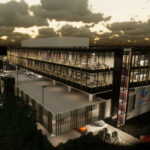Future Trends in Construction Management: How Maple Reinders is Preparing for What’s Next
Posted
January 31, 2025
The construction industry is rapidly evolving, with emerging technologies and sustainable practices reshaping how projects are designed, managed, and built. From digital twin technology and construction robotics to green construction techniques and zero-energy buildings, the future of construction management is focused on improving efficiency, safety, and sustainability. Maple Reinders is leveraging its expertise in Virtual Design and Construction (VDC), BIM, and sustainable building practices, ensuring they continually meet client needs while adapting to the future of construction.

VDC, BIM, and Reality Capture Technologies
Maple Reinders is utilizing Virtual Design and Construction (VDC) and Building Information Modeling (BIM) to enhance project visualization, improve collaboration between stakeholders, and reduce risks. These tools streamline complex projects and allow for more efficient use of resources. To further improve efficiency, Maple integrates lean construction methods and value engineering, ensuring projects are delivered on time, within budget, and with minimal waste.
Maple Reinders’ in-house VDC Team plays a crucial role in implementing technology in projects to enhance efficiency and execution. Our VDC Team leverages various advanced tools and processes like 3D modeling, which helps create a digital representation of a project from CAD or PDF drawings, also known as BIM Model. BIM models are a must in a construction project, as together with improving communication and collaboration across all stakeholders, they are the foundation for the implementation of any advanced tech tool or processes.
Maple VDC has created models for several projects, either for one discipline—like fire protection—or multidisciplinary models, encompassing architectural, structural, and MEP elements, such as for Service Plus Aquatics.
Multidisciplinary models made for Service Plus Aquatics
The VDC team also uses BIM models for 3D coordination and clash detection, which identifies potential issues between building systems early on, saving time and reducing costs. Clash detection has been of great importance for Reiser, to ensure proper coordination between ESFR Sprinklers and Steel structure and above ceiling MEP elements with the structure.
Example of Clashes found between MEP and steel structure in Reiser
Through 4D Scheduling —where time, the 4th dimension, is integrated in the form of a sequence of construction tasks from a schedule associated with 3D elements—the VDC team helps project teams with visually tracking the construction sequencing, ensuring better coordination and planning.
4D Schedule for XYZ Dundas, showcasing elements for site logistics for additional clarity for planning
5D Schedule for Duffin Creek. This Animation includes information regarding cost overtime in the project, therefore it can be defined as 5D (where cost is the 5th dimension)
Additionally, Maple Reinders utilizes cutting-edge reality capture technology such as drones, with in-house licensed drone pilots, laser scanning, and surveying. Drone flights support progress tracking by comparing data from different times, helping analyze site changes.
Comparison of orthographic drone images from James Snow Business Park
By overlaying BIM models to three-dimensional maps from drone flights it is possible to identify any discrepancies with design documentation. Laser scanning uses LIDAR technology to capture precise existing site conditions in the form of three-dimensional point clouds. This technology provides highly accurate 3D representations, allowing the team to verify the existing conditions against BIM models for effective coordination.
Heat Map comparison between existing conditions captured through Laser Scanning and BIM Model of the existing facility for Butcher Shoppe
Reality capture technology, combined with BIM models, streamlines processes by providing accurate visualizations, enhancing project communication, and identifying issues before they arise. The use of these tools from the beginning of a project ensures smoother execution, minimizes rework, and ultimately leads to successful project delivery.
Sustainable Building
Maple Reinders is committed to sustainable building practices like mass timber construction and the development of zero-energy buildings, ensuring that projects are both eco-friendly and cost-efficient in the long term. These techniques support Maple’s commitment to building a more sustainable future for the industry.
Site Analysis and Selection Innovations
In addition to these technological advancements, Maple Reinders implements advanced site analysis and selection innovations to ensure optimal project planning and execution. By leveraging data and analytics, Maple enhances site selection, which improves project feasibility, reduces risks, and ensures projects are positioned for long-term success. These innovations help Maple Reinders deliver projects that meet both client needs and environmental standards.
Conclusion
As the construction industry continues to evolve, driven by advancements in technology and sustainability, Maple Reinders is poised to meet the challenges of tomorrow with forward-thinking solutions. By leveraging cutting-edge VDC applications, reality capture technologies, sustainable building practices, and data-driven site analysis innovations, Maple Reinders continues to optimize project delivery. These efforts not only enhance efficiency and reduce risk but also ensure long-term value for clients. With a strong commitment to innovation and sustainability, Maple Reinders remains at the forefront of modern construction management, prepared to adapt and thrive in the years ahead.
Contact us today to learn how our innovative services can help you achieve your goals.
